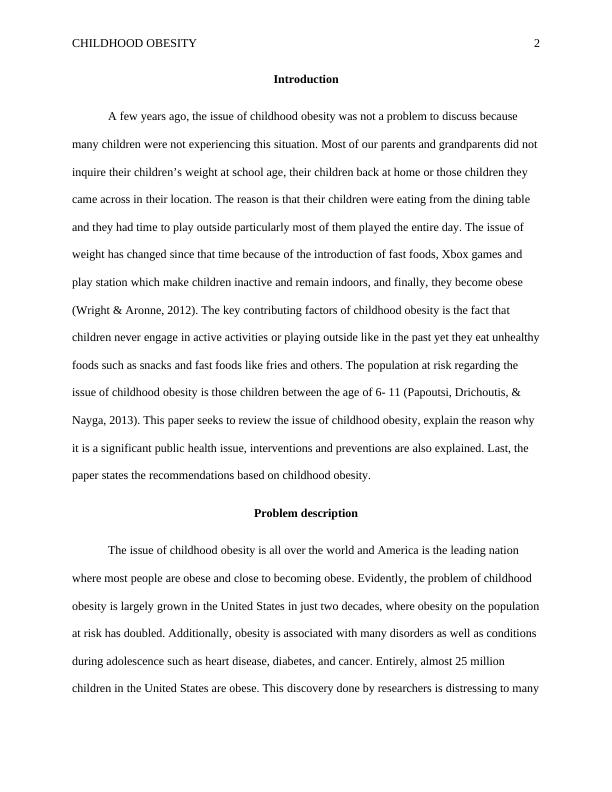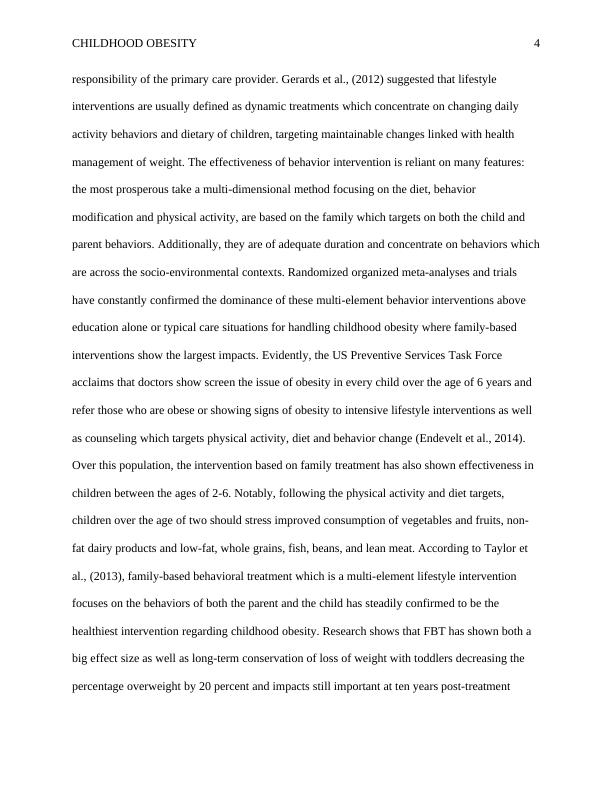HCM320 - The Issue of Childhood Obesity Report
Added on 2020-02-24
11 Pages3181 Words107 Views
Running head: CHILDHOOD OBESITY1Childhood ObesityStudent’s NameInstitution AffiliationDate of Submission

CHILDHOOD OBESITY2IntroductionA few years ago, the issue of childhood obesity was not a problem to discuss because many children were not experiencing this situation. Most of our parents and grandparents did notinquire their children’s weight at school age, their children back at home or those children they came across in their location. The reason is that their children were eating from the dining table and they had time to play outside particularly most of them played the entire day. The issue of weight has changed since that time because of the introduction of fast foods, Xbox games and play station which make children inactive and remain indoors, and finally, they become obese(Wright & Aronne, 2012). The key contributing factors of childhood obesity is the fact that children never engage in active activities or playing outside like in the past yet they eat unhealthyfoods such as snacks and fast foods like fries and others. The population at risk regarding the issue of childhood obesity is those children between the age of 6- 11 (Papoutsi, Drichoutis, & Nayga, 2013). This paper seeks to review the issue of childhood obesity, explain the reason why it is a significant public health issue, interventions and preventions are also explained. Last, the paper states the recommendations based on childhood obesity. Problem descriptionThe issue of childhood obesity is all over the world and America is the leading nation where most people are obese and close to becoming obese. Evidently, the problem of childhood obesity is largely grown in the United States in just two decades, where obesity on the populationat risk has doubled. Additionally, obesity is associated with many disorders as well as conditions during adolescence such as heart disease, diabetes, and cancer. Entirely, almost 25 million children in the United States are obese. This discovery done by researchers is distressing to many

CHILDHOOD OBESITY3citizens in America, and it has instigated several debates on ways in which people can control theissue among children and young adults (Lakshman, Elks, & Ong, 2012). The issue on childhood obesity is trending everywhere, and there are adverts concerning it on electronic media. Childhood obesity is a very famous problem on mainstream talk shows where even Oprah includes it as an episode at least once every term. At least every individual knows a child who is obese and living unhappy, and the rate is increasing every time. The issue of childhood obesity may be instigating by emotional, physiological and familial features although there is a small ratio caused by genetic factors (WHO, 2016). Current Evidence-based Health Promotion Interventions and ApproachesAccording to Rajalakshmi Lakshman, MD, PhD1, Cathy E. Elks, PhD, MPhil1, and Ken K. Ong, MB BChir PhD1 (2012), family pediatricians and physicians have a chance for early identification of obesity and overweight through predictable physical check-ups. Nevertheless, currently, the evidence states that primary care-based management lacking interventionist backing is not enough in order to manage childhood obesity. Primary care based intervention is likely to be more efficient when implanted at a greater intensity by a professional interventionist.Additionally, adolescent females taking part in a weekly group sitting for a period of three months shadowed by two weeks meetings for two months lessened self-effacingly, not importantly, in BMI elements associated with normal care control collection. An additional intensive examination that accomplished in primary care that concentrated on physical activity and diet habit change in both parents and preschoolers demonstrated higher loss of weight compared to control. Therefore, any treatment which is delivered in primary care should be the great intensity to be consistent and effective screening for obesity and overweight and appointment to evidence-based care provided in and outside the health center can be an optimal

CHILDHOOD OBESITY4responsibility of the primary care provider. Gerards et al., (2012) suggested that lifestyle interventions are usually defined as dynamic treatments which concentrate on changing daily activity behaviors and dietary of children, targeting maintainable changes linked with health management of weight. The effectiveness of behavior intervention is reliant on many features: the most prosperous take a multi-dimensional method focusing on the diet, behavior modification and physical activity, are based on the family which targets on both the child and parent behaviors. Additionally, they are of adequate duration and concentrate on behaviors whichare across the socio-environmental contexts. Randomized organized meta-analyses and trials have constantly confirmed the dominance of these multi-element behavior interventions above education alone or typical care situations for handling childhood obesity where family-based interventions show the largest impacts. Evidently, the US Preventive Services Task Force acclaims that doctors show screen the issue of obesity in every child over the age of 6 years and refer those who are obese or showing signs of obesity to intensive lifestyle interventions as well as counseling which targets physical activity, diet and behavior change (Endevelt et al., 2014). Over this population, the intervention based on family treatment has also shown effectiveness in children between the ages of 2-6. Notably, following the physical activity and diet targets, children over the age of two should stress improved consumption of vegetables and fruits, non-fat dairy products and low-fat, whole grains, fish, beans, and lean meat. According to Taylor et al., (2013), family-based behavioral treatment which is a multi-element lifestyle intervention focuses on the behaviors of both the parent and the child has steadily confirmed to be the healthiest intervention regarding childhood obesity. Research shows that FBT has shown both a big effect size as well as long-term conservation of loss of weight with toddlers decreasing the percentage overweight by 20 percent and impacts still important at ten years post-treatment

End of preview
Want to access all the pages? Upload your documents or become a member.
Related Documents
Health Promotion: Munch and Move Intervention Among Childrenlg...
|17
|4498
|411
Childhood Obesity in UK: Causes, Consequences, Prevention, and Health Promotionlg...
|11
|782
|79
Obesity Prevention in Children and Youths in a Community Settinglg...
|11
|2929
|145
EVIDENCE-BASED NURSING PRACTICE-CHILDHOOD OBESITY.lg...
|8
|1990
|85
Childhood Obesity: Causes, Symptoms, Prevention, and Consequenceslg...
|16
|807
|190
Research Aims and Objectiveslg...
|9
|3022
|20
